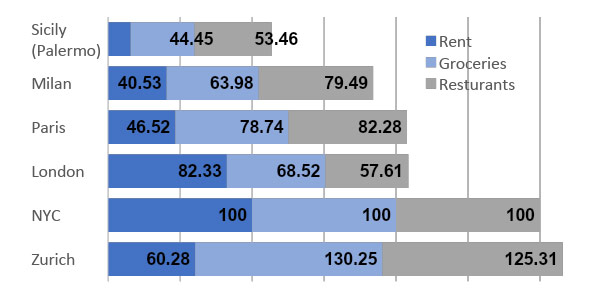The Region
Sicily is the largest island of Italy and of the Mediterranean Sea. It is located in the middle of the Mediterranean sea between the Tyrrhenian Sea (at north) and the Ionian Sea (at east). Sicily is separated from the Italian mainland by the Strait of Messina that separates it from the Italian South Regions. It is separated from the closer point of North Africa by the Strait of Sicily.
Capital: Palermo
Total area: 25,710 Km² – 9,927 Mi²
Total Population: 4,999,891 people
Total cost length: 1,484 Km – 922 Mi (estimated)
Highest point: Mount Etna (3,323 M – 10,922 Ft)
Shorter distance from north Africa: 145 Km
History
Sicily is at the crossroad of civilization with a real historical and cultural melting pot. “Sicily,” said Goethe, “is the key to everything.”, the stepping-stone between Europe and Africa, the link between the Latin West and the Greek East.
Sicily is a region rich in history. It flourished under the Greek and Roman Empire. Sicily’s strategic location has tempted the Byzantines, the Muslims and several European kingdoms that all brought their influences in the culture, the arts and the architecture of the region and made Sicily the center of economic and trade routes.
Thereafter the modern history of Sicily, part of the Kingdom of the two Sicilies, has been under the influence of the Austrian Dynasty of the D’Asburgo and the Italian Dynasty of the Borboni. In 1860, after the Garibaldi’s Expedition of the Thousand, the territory of Sicily entered the Italian Kingdom. In 1946, it has been constituted the Sicilian region as it known today.
Cost of living
The cost of living in Sicily is favorable to students. The cost of living is between the lowest in Italy and in Europe, as shown by the following index of prices compared to the data on living in NYC.

Weather conditions
Weather in the Sicilian Region is among the best in Europe. It creates the perfect living environment for international students, in particular for north African and Middle East students.
Sunny days (on average): 300 d/y
Summer average temperature: 28-29 C°
Winter average temperature: 11-12 C°
Winter weather lasts for: 3 months (Dec-Feb)
Summer sea temperature: 27 C°
Winter sea temperature: 15 C°
Precipitation (on average): 40-60 cm/y
Gastronomic traditions
Italy is worldwide recognized for its gastronomic tradition. Sicily has 64 agri-food European certified quality products.
The eno-gastronomic legacy of the Region derives from traditions, intercultural exchange and weather conditions.
Bastion of the Mediterranean diet, Sicily is known for its fruit and vegetables production, such as, the typical red oranges, prickly pear plants, and the green pistachio coming from Bronte.
It is worldwide famous for its baker products, pastry and sweets: bread, arancini, cannoli with ricotta, granita, Modica chocolate and cassata are only some of the many examples.
Noteworthy, the merge of tradition and new technologies for the production of different typologies of olive oil thanks, in addition, to the best weather conditions of the island.
Local Communities
The geographical central position of Sicily has always favoured the creation of international communities in the territory.
In Sicily are living more than 200,000 people coming from the rest of the word.
Living in Sicily
![]() Tunisia: ≈ 21.000 people
Tunisia: ≈ 21.000 people
![]() Morocco: ≈ 15.500 people
Morocco: ≈ 15.500 people
![]() Algeria: ≈ 1.100 people
Algeria: ≈ 1.100 people
![]() Jordan: ≈ 50 people
Jordan: ≈ 50 people
Cultural heritage
In Sicily, there are 7 UNESCO World Heritage Sites, together with many other cultural sites, from Classical, Medieval and Renaissance periods.
UNESCO World Heritage Sites

Useful links
History
http://www.treccani.it/enciclopedia/sicilia/
Weather conditions
http://www.sias.regione.sicilia.it/
Cultural Heritage
http://unescosicilia.it/wp/?lang=en
http://www.visitsicily.info/en/patrimonio-unesco/
Gastronomic tradition
https://dopigp.politicheagricole.it/it/scopri-il-territorio
http://www.visitsicily.info/turismo/percorsi-enogastronomici/
Communities
http://dati.istat.it/Index.aspx?DataSetCode=DCIS_POPSTRCIT1


